 W
WThe Admiralty Fire Control Table (A.F.C.T.) was an electromechanical analogue computer fire-control system that calculated the correct elevation and deflection of the main armament of a Royal Navy cruiser or battleship, so that the shells fired would strike a surface target. The AFCT MK 1 was fitted to HMS Nelson and Rodney in the early 1920s, while the battleships Warspite, Valiant, and Queen Elizabeth, and the battlecruiser Renown, received Mk VII tables in the late 1930s. Battleships of the King George V class received a Mk IX table, while Vanguard received the final variant, the Mk X. The AFCT was the successor to the Dreyer tables, developed by Captain Frederic Charles Dreyer, and the Argo Clock, developed by Arthur Pollen, and received developmental input from both men.
 W
WIn military usage, a barrage is massed sustained artillery fire (shelling) aimed at a series of points along a line. In addition to attacking any enemy in the kill zone, a barrage intends to suppress enemy movements and deny access across that line of barrage. The impact points along the line may be 20–30 yards/meters apart, with the total line length of the barrage zone anything from a few hundred to several thousand yards/meters long. Barrages can consist of multiple such lines, usually about 100 yards/meters apart, with the barrage shifting from one line to the next over time, or several lines may be targeted simultaneously.
 W
WA bombardment is an attack by artillery fire or by dropping bombs from aircraft on fortifications, combatants, or towns and buildings.
 W
WCannon operation required specialised crew and gunners, who were first enlisted by the Spanish in the 14th century. The nature of cannon operation often depended on the size of the cannon and whether they were breech-loading or muzzle-loading. English cannons of the late 14th century became mobile, while the largest cannon required huge crews to transport and operate them.
 W
WIn the military science of ballistics, circular error probable (CEP) is a measure of a weapon system's precision. It is defined as the radius of a circle; centered on the mean, whose boundary is expected to include the landing points of 50% of the rounds; said otherwise, it is the median error radius. That is, if a given munitions design has a CEP of 100 m, when 100 are targeted at the same point, 50 will fall within a circle with a radius of 100 m around their average impact point.
 W
WIn the U.S. Army Coast Artillery Corps, the term fire control system was used to refer to the personnel, facilities, technology and procedures that were used to observe designated targets, estimate their positions, calculate firing data for guns directed to hit those targets, and assess the effectiveness of such fire, making corrections where necessary.
 W
WThe Cora was a digital fire-control system designed by Peter Toth and produced by the Swiss company Contraves.
 W
WThe depression range finder (DRF) was a fire control device used to observe the target's range and bearing to calculate firing solutions when gun laying in coastal artillery. It was the main component of a vertical base rangefinding system. It was necessitated by the introduction of rifled artillery from the mid-19th century onwards, which had much greater ranges than the old smoothbore weapons and were consequently more difficult to aim accurately. The DRF was invented by Captain H.S.S. Watkin of the Royal Artillery in the 1870s and was adopted in 1881. It could provide both range and bearing information on a target. The device's inventor also developed a family of similar devices, among them the position finder, which used two telescopes as a horizontal base rangefinding system, around the same time; some of these were called electric position finders. Some position finders retained a depression range finding capability; some of these were called depression position finders. Watkin's family of devices were deployed in position finding cells, a type of fire control tower, often in configurations that allowed both horizontal base and vertical base rangefinding. Watkin's system included automatic electrical updating of range and bearing dials near the guns as the position finders were manipulated, and a system of remotely firing the guns electrically from the position finding cell. The improved system was trialled in 1885 and widely deployed in the 1890s. Functionally equivalent devices were developed for the United States Army Coast Artillery Corps and its predecessors, called depression position finders or azimuth instruments depending on function, adopted in 1896 and deployed widely beginning in the early 1900s as the Endicott program of modern coastal defences was built. These devices were also used by both countries to control submarine (underwater) minefields.
 W
WDirect fire refers to firing of a ranged weapon whose projectile is launched directly at a target within the line-of-sight of the user. The firing weapon must have a sighting device and an unobstructed view to the target, which means no obstacles or friendly units can be between it and the target. A weapon engaged in direct fire conversely exposes itself to direct return fire from the target.
 W
WThe directing point (DP) was a term used in the U.S. Coast Artillery to identify a precisely surveyed point that was used as the point of reference for preparing the firing data used to aim the guns of a given Coast Artillery battery.
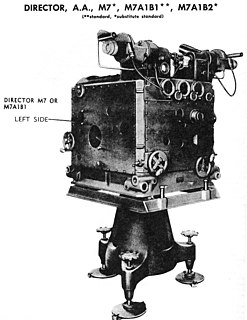 W
WA director, also called an auxiliary predictor, is a mechanical or electronic computer that continuously calculates trigonometric firing solutions for use against a moving target, and transmits targeting data to direct the weapon firing crew.
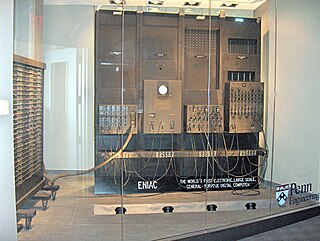 W
WENIAC was the first programmable, electronic, general-purpose digital computer. It was Turing-complete and able to solve "a large class of numerical problems" through reprogramming.
 W
WFire discipline is a system of communication in the military, primarily for directing artillery. By definition, fire discipline is the language of fire control. It consists of words, phrases, rules, and conventions which have specific meanings and which result in some definite action being taken with the guns. All ranks concerned in fire control must be thoroughly familiar with the language and the resulting actions. The aim of fire discipline is to ensure that in response to calls for fire, the appropriate action is taken at the FPC, FSCC, FDC and at the Guns/MRL, strictly in accordance with the intentions of the originator and with the minimum of delay.
 W
WA fire-control system is a number of components working together, usually a gun data computer, a director, and radar, which is designed to assist a ranged weapon system in targeting, tracking and hitting its target. It performs the same task as a human gunner firing a weapon, but attempts to do so faster and more accurately.
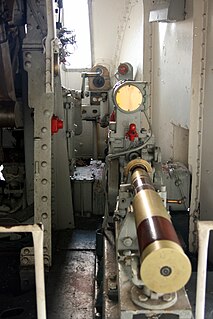 W
WThe Fuze Keeping Clock (FKC) was a simplified version of the Royal Navy's High Angle Control System analogue fire control computer. It first appeared as the FKC MkII in destroyers of the 1938 Tribal class, while later variants were used on sloops, frigates, destroyers, aircraft carriers and several cruisers. The FKC MkII was a non-tachymetric anti-aircraft fire control computer. It could accurately engage targets with a maximum speed of 250 knots.
 W
WGun laying is the process of aiming an artillery piece or turret, such as a gun, howitzer, or mortar, on land, in air, or at sea, against surface or aerial targets. It may be laying for direct fire, where the gun is aimed similarly to a rifle, or indirect fire, where firing data is calculated and applied to the sights. The term includes automated aiming using, for example, radar-derived target data and computer-controlled guns.
 W
WHigh Angle Control System (HACS) was a British anti-aircraft fire-control system employed by the Royal Navy from 1931 onwards and used widely during World War II. HACS calculated the necessary deflection required to place an explosive shell in the location of a target flying at a known height, bearing and speed.
 W
WAn air burst or airburst is the detonation of an explosive device such as an anti-personnel artillery shell or a nuclear weapon in the air instead of on contact with the ground or target. The principal military advantage of an air burst over a ground burst is that the energy from the explosion is distributed more evenly over a wider area; however, the peak energy is lower at ground zero.
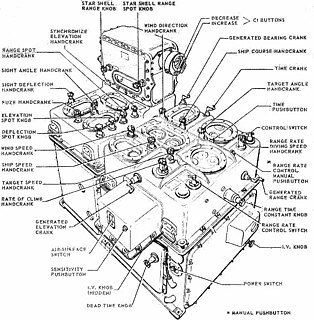 W
WThe Mark 1, and later the Mark 1A, Fire Control Computer was a component of the Mark 37 Gun Fire Control System deployed by the United States Navy during World War II and up to 1969 or later. It was developed by Hannibal Ford of the Ford Instrument Company. It was used on a variety of ships, ranging from destroyers to battleships. The Mark 37 system used tachymetric target motion prediction to compute a fire control solution. Weighing more than 3,000 pounds (1,400 kg), the Mark 1 itself was installed in the plotting room, a watertight compartment that was located deep inside the ship's hull to provide as much protection against battle damage as possible.
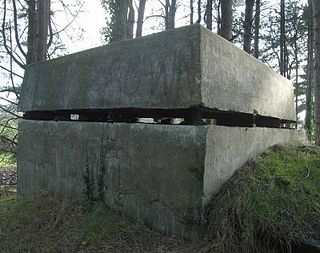 W
WAn observation post, temporary or fixed, is a position from which soldiers can watch enemy movements, to warn of approaching soldiers, or to direct artillery fire. In strict military terminology, an observation post is any preselected position from which observations are to be made - this may include very temporary installations such as a vehicle parked as a roadside checkpoint, or even an airborne aircraft.
 W
WA plotting room was the co-ordination centre of a fire control system for guns used against enemy ships or aircraft, whether naval guns or coastal artillery. The plotting room received data on ship or aircraft position and motion from fire control instruments or their operators and determined and transmitted the range and bearing the guns would fire on. Plotting rooms came into use in the early 1900s for coastal artillery and during World War I for warships as gun ranges increased, and were in general use through the 1970s on World War II-era ships. Warships had plotting rooms for naval fire control for guns from 5-inch to 18-inch calibre, including anti-aircraft use for the smaller guns. On armoured ships such as battleships and cruisers, plotting rooms were located in the armoured citadel, protected by both deck and belt armour. With a few exceptions, coastal defence gun installations were inactivated shortly after World War II (US) through the middle 1950s (UK). Equipment in plotting rooms included specialised plotting boards and other analogue devices; by World War II these were supplemented or replaced by electro-mechanical gun data computers. Data could be received and transmitted by telephone, or directly via dedicated electrical systems. Locations of plotting rooms in coastal defence installations varied greatly; they could be in low-rise structures such as base end stations, taller fire control towers, in gun battery structures, or in bunkers separate from gun batteries.
 W
WPlunging fire is a form of indirect fire, where gunfire is fired at a trajectory to make it fall on its target from above. It is normal at the high trajectories used to attain long range, and can be used deliberately to attack a target not susceptible to direct or grazing fire due to not being in direct line of sight.
 W
W"Pom-Pom" director was a director for British anti-aircraft guns on British warships of the 1930s into the Second World War.
 W
WPredicted fire is a tactical technique for the use of artillery, enabling it to fire for effect without alerting the enemy with ranging shots or a lengthy preliminary bombardment. The guns are laid using detailed calculations and surveys to achieve accurate fire from the first round.
 W
WA Quaker gun is a deception tactic that was commonly used in warfare during the 18th and 19th centuries. Although resembling an actual cannon, the Quaker gun was simply a wooden log, usually painted black, used to deceive an enemy. Misleading the enemy as to the strength of an emplacement was an effective delaying tactic. The name derives from the Religious Society of Friends or "Quakers", who have traditionally held a religious opposition to war and violence in the Peace Testimony.
 W
WRangekeepers were electromechanical fire control computers used primarily during the early part of the 20th century. They were sophisticated analog computers whose development reached its zenith following World War II, specifically the Computer Mk 47 in the Mk 68 Gun Fire Control system. During World War II, rangekeepers directed gunfire on land, sea, and in the air. While rangekeepers were widely deployed, the most sophisticated rangekeepers were mounted on warships to direct the fire of long-range guns.
 W
WShip gun fire-control systems (GFCS) are analogue fire-control systems that were used aboard naval warships prior to modern electronic computerized systems, to control targeting of guns against surface ships, aircraft, and shore targets, with either optical or radar sighting. Most US ships that are destroyers or larger employed gun fire-control systems for 5-inch (127 mm) and larger guns, up to battleships, such as Iowa class.
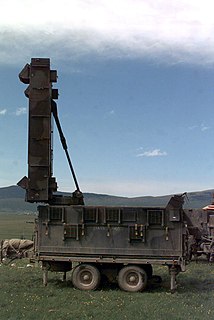 W
WShoot-and-scoot is an artillery tactic of firing at a target and then immediately moving away from the location from where the shots were fired to avoid counter-battery fire.
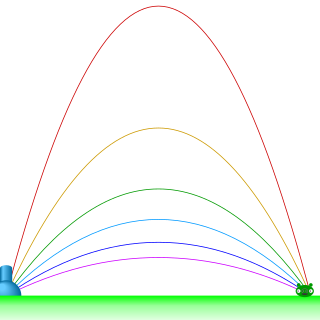 W
WTime On Target (TOT) is the military co-ordination of artillery fire by many weapons so that all the munitions arrive at the target at roughly the same time. The military standard for coordinating a time-on-target strike is plus or minus three seconds from the prescribed time of impact.
 W
WA traveling forge, when combined with a limber, comprised wagons specifically designed and constructed as blacksmith shops on wheels to carry the essential equipment necessary for blacksmiths, artisans and farriers to both shoe horses and repair wagons and artillery equipment for both U.S. and Confederate armies during the American Civil War, as well as by western European armies. The traveling forge was frequently also referred to in The Official Records simply as a forge, and sometimes referred to by Civil War buffs as a battery forge.
 W
WThe Vickers Range Clock was a clockwork device used by the Royal Navy for continuously calculating the range to an enemy ship.